Microelectronics10 Area, uP, Register, Scan cellProf. Dr. Jörg Vollrath09 VHDL, FPGA and Delay |
Video of lecture 11 (9.06.2021)
|
Länge: 1:30:00 |
0:0:15 Review Delay, Today: Registers, test 0:3:0 D-Flip-Flop 0:5:10 Function of a D-Flip-Flop 0:11:45 positive edge, rising clock triggered D-Flip-Flop 0:13:50 Setup and hold time 0:18:55 Slew rate measurement 0:22:15 Clock synchronous operation minimum cycle time 0:25:55 Measuring, simulating setup and hold time 0:29:25 Shmoo 0:34:0 Negativ setup time with delay on clk 0:34:58 Finite state machine 0:38:3 state transition table 0:38:32 State transition table 0:3:20 VHDL code 0:7:19 Test 0:12:50 Truth table and test 0:16:16 NAND Gate simulation with error 0:20:30 Pure logic test 0:24:0 Number of test vectors 0:26:10 Scann cell D-Flip-Flop 0:29:50 Scan cell in Tiny FPGA 0:32:7 Textual scan cell specification 0:34:0 State table 0:36:0 Scan cell schematic |
Overview
Review:- VHDL, VHDL Books
- ASIC, FPGA, Microprocessor
- Delay: Inverter Sizing, Pipeline
Today:
- Microelectronics system design
- Area per transistor
- Microprocessor
- Latch, state machine, scan cell
Microelectronics System Design
Boundary conditions
- Area :
Pad/Pin limited, functional limited - Speed and CLK frequency :
Delay optimization, pipelining - Power :
Use minimum sized transistors, special circuits
Strategy
- Hierarchy
- Find one solution
- Identify root cause of problems
- Fix problems
- Automation is needed to repeat these steps successfully
fast, with no new errors
Reviewing microelectronics system design identifies the most important boundary conditions
and the most successfull strategies for the task.
Area estimation
2 λ = F (feature size)Typical layout densities
| Element | Area |
| random logic (2-level metal) | 1000-1500 λ2 / transistor |
| datapath | 250-750 λ2 / transistor |
| SRAM | 1000 λ2 / bit |
| DRAM (in a DRAM process) | 100 λ2 / bit |
| ROM | 100 λ2 / bit |
Typical examples with synthesis in Electric?
muddlib.jelib; sclib.jelib;
MIPS R3000A
|
32-bit 2nd generation commercial processor (1988) Led by John Hennessy (Stanford, MIPS Founder) external L1 Caches 1.2 µm process 115 K Transistor 20..33.3 MHz 48 mm2 die 145 I/O Pins VDD = 5 V 4 Watts SGI Workstations Wikipedia |
|
Book: The Pentium Chronicles
|
Robert Colwell, John Wiley & Sons, 32.99 Euro A landmark chip like the P6 or Pentium 4 doesn't just happen. It takes a confluence of brilliant minds, dedication for beyond the ordinary, and management that nurtures the vision while keeping a firm hand on the project tiller. As chief architect of the P6, Robert Colwell offers a unique perspective as he unfolds the saga of a project that ballooned from a few architects to hundreds of engineers, many just out of school. |
Intel processor
|
|
Intel 4004 1971 2300 Tr. 4-Bit 500kHz 10 µm |
|
Intel 8086 1978 29 kTr. 16-Bit 8 Mhz 3.2 µm 33 mm2 |
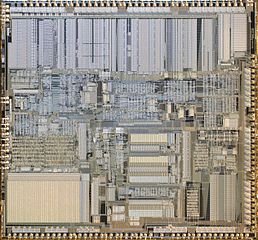
|
Intel 386 1985 275 kTr. 32-Bit 33 MHz 1.5 µm |
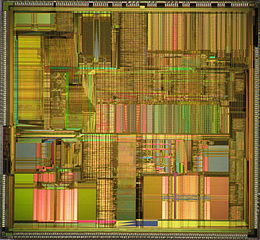
|
Intel Pentium 1993 3.1 MTr. 32-Bit 300 MHz 0.8µm 294mm2 |
Memory looks regular, logic has a random pattern in the chip top view pictures.
Over time more and more area was used for memory.
Due to miniaturization and minimum voltage limit (1V) the power density limits the maximum opeating speed.
Since there is a Vth distribution over the chip and wafer it is difficult to realize a Vth < 300mV. Therefore minimum Vdd = 1V.
Latest integrated circuits: more cores, just copy a block a couple of times and add glue logic
Over time more and more area was used for memory.
Due to miniaturization and minimum voltage limit (1V) the power density limits the maximum opeating speed.
Since there is a Vth distribution over the chip and wafer it is difficult to realize a Vth < 300mV. Therefore minimum Vdd = 1V.
Latest integrated circuits: more cores, just copy a block a couple of times and add glue logic
Microelectronics Limits
- Feature size: Wave length of light source, a few nm
- Feature size: Number of atoms needed for creating n, p regions with doping (100..1000), a few nm
- Supply voltage: dielectric break down and statistic Vth variation VDD = 1 V
- Power density: clock rate limit 3 GHz
D-Flip-Flop
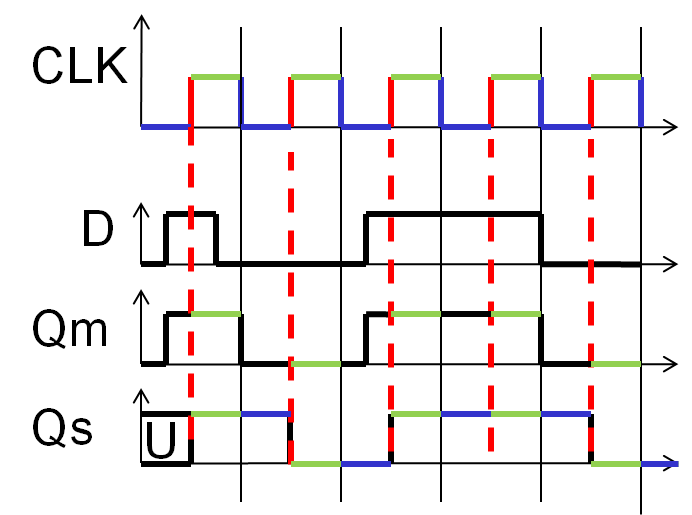 |
This circuit shows a positive edge triggered D-Flip-Flop (DFF).
Data of input D is latched at a rising clock edge (CLK) and Qs and Qb are holding this data until the next rising clock edge.
This is the only relevant flip flop used in digital circuits.
A reset input and testability inputs can be added as shown later.
Data of input D is latched at a rising clock edge (CLK) and Qs and Qb are holding this data until the next rising clock edge.
This is the only relevant flip flop used in digital circuits.
A reset input and testability inputs can be added as shown later.
Setup and Hold Time
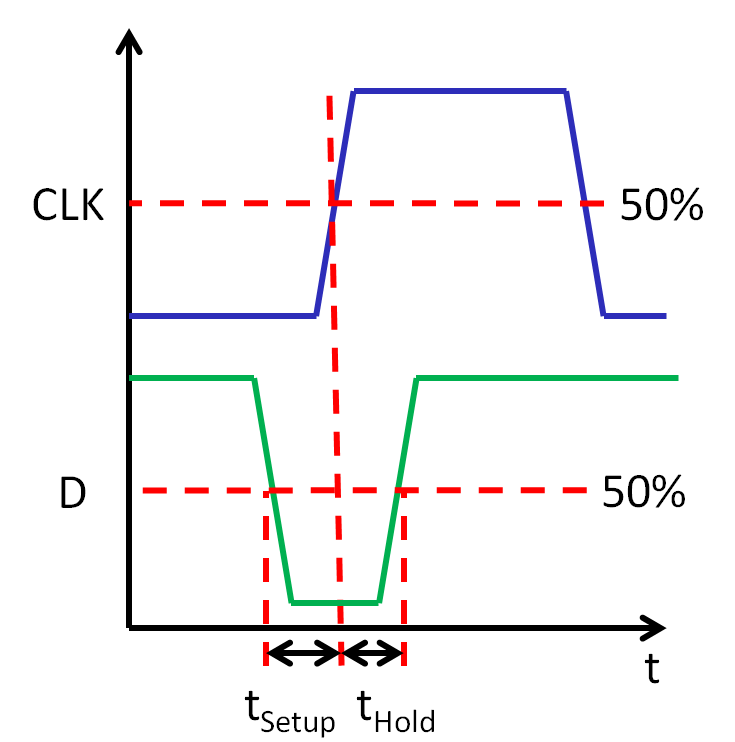
Important timing parameters are setup and hold time of a DFF.
Setup time is needed to transfer the input level to the internal inverters.
Setup time and propagation delay are limiting the maximum clock frequency.
Setup time is needed to transfer the input level to the internal inverters.
Setup time and propagation delay are limiting the maximum clock frequency.
Setup and Hold Time, SPICE Simulation
|
Vary positive CLK edge in regard to input data Not enough setup time, bad output Minimum setup time Register delay from rising clock to output Shmoo plot
VDD
1.2V |xxxxx......|
1.1V |xxxxx......|
1.0V |xxxxx......|
0.9V |xxxxx......|
0.8V |xxxxx......|
-0.5n 0.5n
tsetup
X: Fail
|
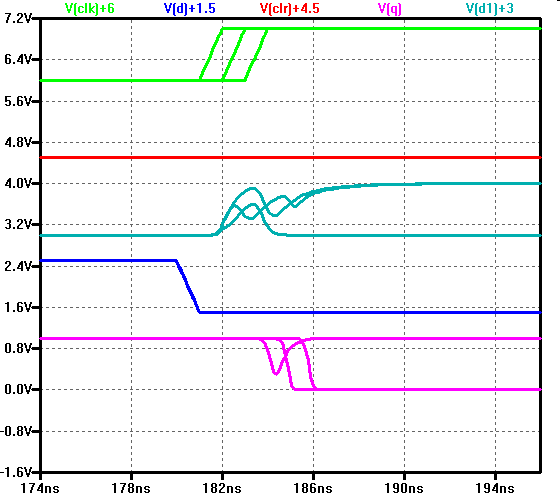 Simulation waveform DFF_test.asc |
Medwedew Finite State Machine
Maximum clock frequency:tCLK > tpdLogic + tsetup + tpdRegister

There are also Mealy and Moore state machines, which make testing more complicated
State diagram, state transition table
 State Diagram
|
|
VHDL state machine entity
entity STATEM is
port ( RESET: in STD_LOGIC,
CLK : in STD_LOGIC,
X : in STD_LOGIC,
R : out STD_LOGIC_VECTOR(2 downto 0));
end STATEM;
FPGA: no reset but initialization: Q := '0';
ASIC: reset
VHDL state machine architecture
architecture BEHAVE of STATEM is
signal RINT: std_logic_vector(2 downto 0) := "000"; -- FPGA
signal state: std_logic_vector(3 downto 0);
begin
state <= X & RINT;
SYN_STATE:process (CLK, RESET)
begin
if RESET = '1' then RINT <= "000"; -- ASIC
elsif CLK='1' and CLK'event then -- positive edge
case state is -- State table
when "0000" => RINT <= "001";
when "1001" => RINT <= "010";
when "0100" => RINT <= "000";
when others => RINT <= "000";
end case;
end if; -- incomplete if
end process SYN_STATE;
R <= RINT; -- connect output
end BEHAVE;
Overview: Test
- Truth table and test
- NAND test: LTSPICE, IRSIM
- Simulator and Measurement: LTSPICE, IRSIM, VHDL
- Timing description and strobing
- Memory effects: Switch and RC
- Scan cell
- Specification: Input, states, outputs
- State table
- Test and measurement
- Partioning big circuits (truth tables) in smaller ones
- Built in self test (BIST)
Half of cost of integrated circuits are spent on test.
Truth table and test
|
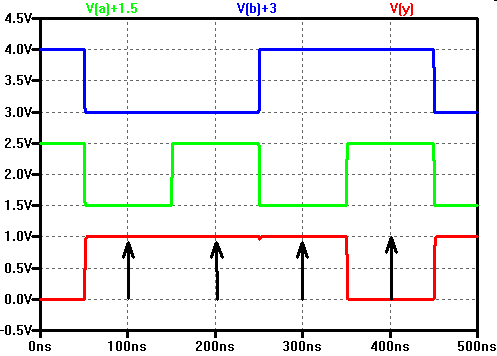 | ||||||||||||||||||
Each line in the truth table is one column, a certain time in simulation or measurement.
All possible combinations have to be tested to prove correct function.
Due to propagation delay output signals are shifted to the right.
Expected output signal is compared to real output signal at certain times (arrows).
All possible combinations have to be tested to prove correct function.
Due to propagation delay output signals are shifted to the right.
Expected output signal is compared to real output signal at certain times (arrows).
NAND Gate Simulation with Error
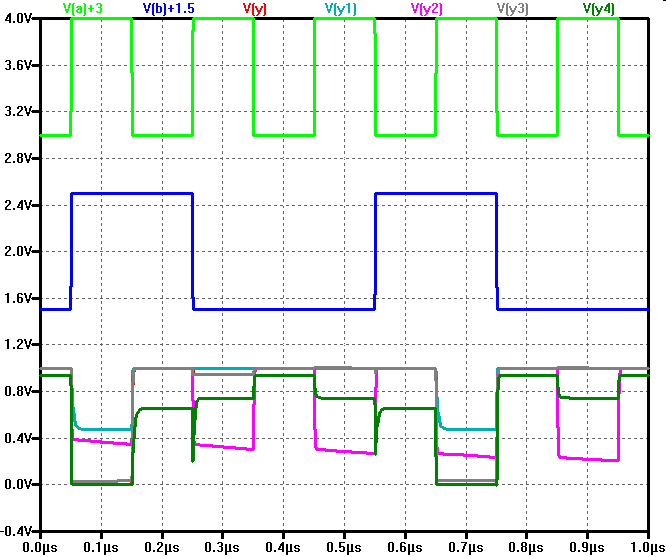
|
Observability of errors requires real voltage sources (Rser).
Missing wires, connections and high ohmic connections are simulated.
Bad behaviour can be seen. The analog output value has to be converted to '0' or '1' using mid level.
It can also be seen, that over time output level is sometimes changing.
This can be a delay fault or a memory effect.
If there is a switch and a capacitor available memories are created.
It is more difficult to test memories.
Missing wires, connections and high ohmic connections are simulated.
Bad behaviour can be seen. The analog output value has to be converted to '0' or '1' using mid level.
It can also be seen, that over time output level is sometimes changing.
This can be a delay fault or a memory effect.
If there is a switch and a capacitor available memories are created.
It is more difficult to test memories.
Pure Logic Test
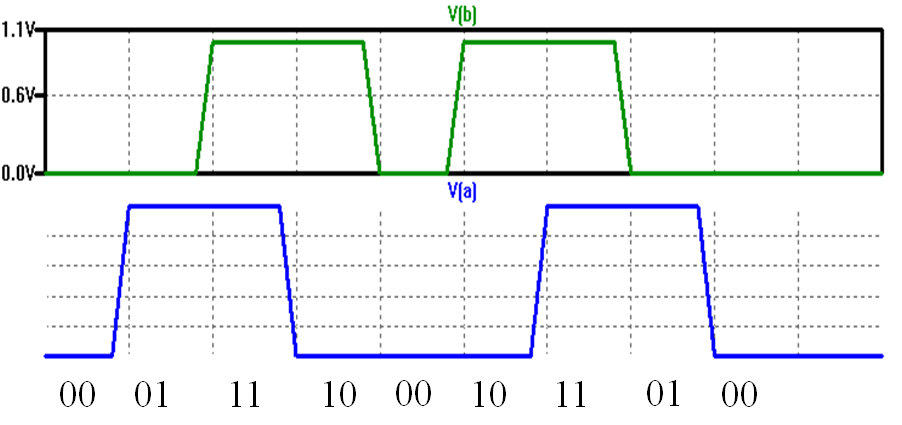
|
|
|
||||||||||||||||||||||||||||||||||||||||
State transition table
| Input | Old State (n) | Output, new state (n+1) | UD | Sn | Sn+1 |
| 0 | 00 | 10 |
| 0 | 01 | 00 |
| 0 | 10 | 01 |
| 0 | 11 | 10 |
| 1 | 00 | 00 |
| 1 | 01 | 10 |
| 1 | 10 | 00 |
| 1 | 11 | 00 |
Test with Latches and Registers
Each latch acts as an input for logic circuitsEach internal latch can only be set indirectly with logic functions
- m latches
- n logic inputs
- Static test:
2(m+n) tests - Number of tests increases with internal latches!
- It is easy to apply '1' and '0' to an input. It is hard to set or reset only a specific latch.
Scannable D-Flip-Flop
Additional pins:|
SE/TE:scan/test enable SDI/TDI: scan/test data in SDO/TDO: scan/test data out Shift register to set and read register 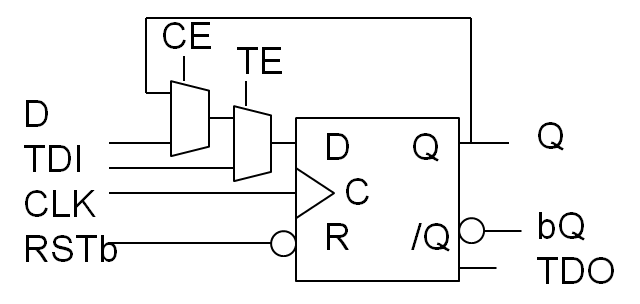
|
Scan cell specification
Input, Output, States
Text
During test test data is written with a rising clock edge into the latch.
Any time output can be reset with an extra signal.
Any time during normal operation clock signal can be disabled with an extra signal.
Text with signal names and states
During test (TE='1') test data (TDI) is written with a rising clock (CLK) edge into the latch (Q(n+1)=TDI(n), Qb(n+1)=!TDI(n), TDO(n+1)=TDI(n)).
Any time output (Q, Qb) can be reset ('0') with an extra signal (RSTb).
Any time during normal operation (TE='0') clock signal (CLK) can be disabled with an extra signal (CE).
State table
Scan Flip Flop: State table
Positive edge triggered flip flop.CLK not in state table.
Asynchronous reset: RSTb is '1' for normal operation.
TE disables CE and RSTb operation.
| TE | RSTb | CE | D | TDI | Qn | Qbn | TDOn | Comment | |
| 0 | 0 | X | X | X | 0 | 1 | 0 | Normal operation, reset to '0' | |
| 0 | 1 | 0 | X | X | Qn-1 | Qbn-1 | TDOn-1 | Normal operation, CE='0' disables clock | |
| 0 | 1 | 1 | 0 | X | 0 | 1 | 0 | Normal operation, Qn = D | |
| 0 | 1 | 1 | 1 | X | 1 | 0 | 1 | ||
| 1 | 0 | X | X | X | TDI | /TDI | TDI | Test, TDOn = TDI | |
| 1 | 1 | X | X | 0 | 0 | 1 | 0 | ||
| 1 | 1 | X | X | 1 | 1 | 0 | 1 |
Serial test data is loaded into all FFs with TE="1" and CLK toggling.
Then logic is evaluated with TE="0" and a rising CLK edge.
Results are serial shifted out with TE="1" and CLK toggling.
Since Q is toggling during serial shift operation, no worst case timing behaviour is measured.
Then logic is evaluated with TE="0" and a rising CLK edge.
Results are serial shifted out with TE="1" and CLK toggling.
Since Q is toggling during serial shift operation, no worst case timing behaviour is measured.
Scan Flip Flop: Schematic
This cell is included in sclib.jelib as Scan_cell.
Implementation of CE is difficult. It is assumed that CE is only going low during CLK high.
CDL affects propagation delay.
CDL=1p, 36ns CLK to Q; 57ns RSTb to Q;
CDL=0.1p 6ns CLK to Q
CDL=0.01p: 3ns CLK to Q
Implementation of CE is difficult. It is assumed that CE is only going low during CLK high.
CDL affects propagation delay.
CDL=1p, 36ns CLK to Q; 57ns RSTb to Q;
CDL=0.1p 6ns CLK to Q
CDL=0.01p: 3ns CLK to Q
Scan Flip Flop: Simulation
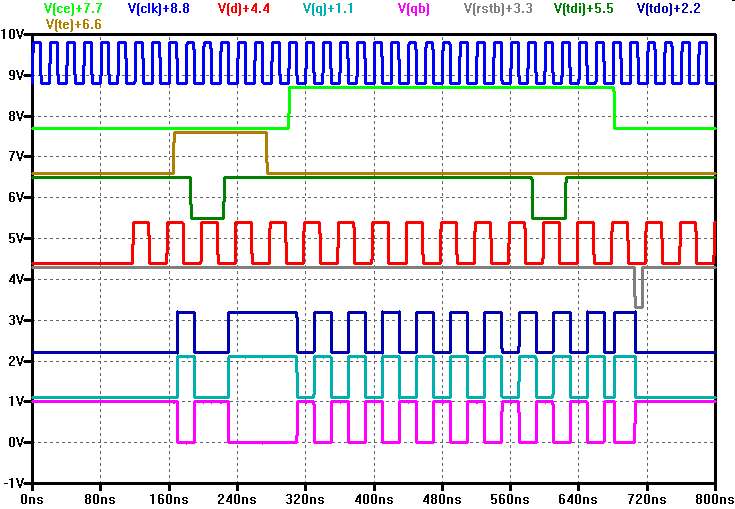
800ns simulation time with CLK cycle 20ns gives 40 test vectors.
LTSPICE simulation code:
Each row in the state table is a CLK cycle column in the simulation.
Simulation starts with CE low.
Betwenn 166 ns and 274 ns TE operation is checked.
At 300 ns CE goes active. D is transfered into the D-FF.
At 705 ns reset is applied and the output Q goes to 0.
Is the testing complete?
Is the circuit working correctly?
Test coverage:
25 = 32 input combinations (vectors).
TE,RSTb,CE,D,TDI: 010X1, 110XX, 011XX, 00001
11 combinations tested
TC = 11/32 = 34.3%
JavsScript generating test vectors: TestJS.html
Nr CE TE TDI D RSTb xTDO xQ xQB 0 0 0 1 0 1 1 1 0 Start 6x 6 0 0 1 1 1 1 1 0 Keep state 7 0 0 1 0 1 1 1 0 Keep state 8 0 1 1 1 1 1 1 0 TE active
LTSPICE simulation code:
.global VDD
.option TEMP 90
VDD VDD 0 DC 1
VCLK CLK 0 PULSE(0 1 0n 1n 1n 8n 20n)
VCE CE 0 PULSE(0 1 300n 1n 1n 380n 600n)
VCLR RSTb 0 PULSE(1 0 705n 1n 1n 8n 2800n)
VD D 0 PULSE(0 1 117.2n 1n 1n 18n 40.05n)
VTDI TDI 0 PULSE(1 0 185n 1n 1n 38n 400n)
VTE TE 0 PULSE(0 1 165n 1n 1n 108n 2800n)
.include cmosedu_models.txt
.tran 0 800n
Each row in the state table is a CLK cycle column in the simulation.
Simulation starts with CE low.
Betwenn 166 ns and 274 ns TE operation is checked.
At 300 ns CE goes active. D is transfered into the D-FF.
At 705 ns reset is applied and the output Q goes to 0.
Is the testing complete?
Is the circuit working correctly?
Test coverage:
25 = 32 input combinations (vectors).
TE,RSTb,CE,D,TDI: 010X1, 110XX, 011XX, 00001
11 combinations tested
TC = 11/32 = 34.3%
JavsScript generating test vectors: TestJS.html
Scan Flip Flop: Schematic improved CE
Scan chain operation
|
Initial data can be scanned in with SE/TE and CLK SE/TE is disabled and for one CLK cycle normal operation is done Resulting data is scanned out using SE/TE and CLK |
Application: Tiny FPGA
|
How many test vectors are needed? How many subcircuits to test? How to document test vectors? |

|
This was a laboratory task.
This circuit demonstrates an FPGA with 2 inputs (I0, I1), lookup table LUT2, switches (MUX) and outputs O0, O1.
Internal output signals Y can be fed back with Y0, Y1 to the input MUXes for state machines.
The TE, TDI, TDO interface configures MUX and LUT2 circuits.
This circuit demonstrates an FPGA with 2 inputs (I0, I1), lookup table LUT2, switches (MUX) and outputs O0, O1.
Internal output signals Y can be fed back with Y0, Y1 to the input MUXes for state machines.
The TE, TDI, TDO interface configures MUX and LUT2 circuits.
Dynamic Scan Flip Flop: Schematic
A separate path for test data is needed with a separate clock.
Test data is loaded serially, while normal data is still kept at the output Q and Qb.
Disabling TE and applying a clock transfers test data to the Q output and then through logic to the next FF.
This makes timing measurements possible.
Test data is loaded serially, while normal data is still kept at the output Q and Qb.
Disabling TE and applying a clock transfers test data to the Q output and then through logic to the next FF.
This makes timing measurements possible.
Summary
- Area estimation and microprocessors
- D-Flip-Flop, registers
- Test: Scan cell